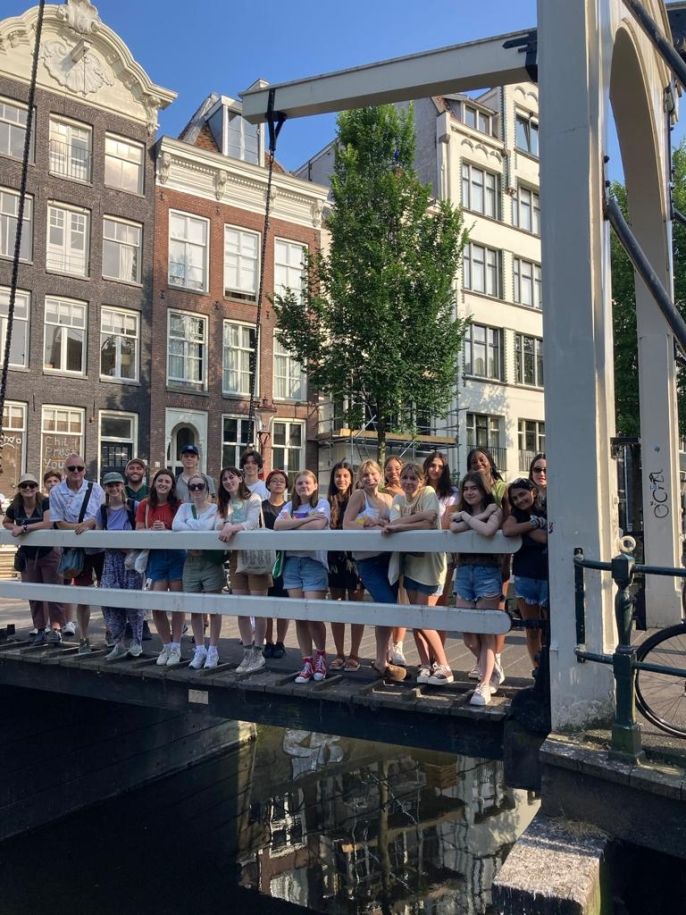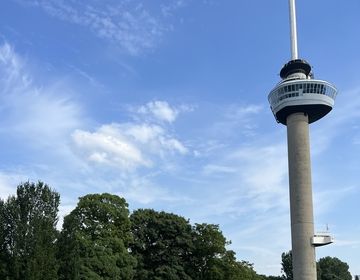Student Takeover: Reflections from Amsterdam
Written by Kit Terry
After a tour down Amsterdam’s winding streets of brick bridges and peaking wisteria, I think all of us had fallen in love with the city. Even Oosterpark, the small public pond and greenery outside our hostel, showcases much of the beauty Amsterdam has to offer: bikers in vibrant outfits shoot past our groups at a scarily fast pace, children run in its death-defying playgrounds, and some of our very talented fellow navigators are even able to climb on its public workout equipment. It has been very easy to romanticize a city that quite obviously prioritizes the well-being of its residents through investments in the infrastructure that make this vibrancy possible.
In our first few days of class our passionate and knowledgeable instructor gave us a name for this sort of economy. A city run on a doughnut economic model focuses on meeting the societal needs of its inhabitants without over-stressing the limits of the environment. She also provided us with many models of how the government goes about ensuring that all residents of Amsterdam are in the “safe zone for humanity”, going into depth about how these policy choices have had far-reaching political consequences, such as the formation of the right-wing anti-environment Farmer’s Party.
Our instructor also stressed that doughnut economics as a theory has only been applied to cities that are already wealthy enough to support their many requirements. We then watched a few videos about how Amsterdam made its wealth—a dark history, with an undercurrent of colonialism throughout. By exploiting its colonies in Indonesia and the Dutch Caribbean, the Netherlands was able to build itself a sizable fortune through the Dutch East India Company, or the VOC. It seems that the city’s dainty canals were perhaps not the innocent nooks that they appeared on our neighborhood walk.
Later that day, we had the opportunity to tour the Maritime Museum. I was surprised by the analysis methods the tour guide employed, as he encouraged us to consider the paintings housed in the museum with a critical lens, questioning the truths they were presenting. We discussed how different races were presented in art and then toured a VOC ship used for transporting goods to Asia. After some fun facts about bathroom use, we toured the ship’s bottom, which would have held hundreds of crates in the 17th century and near a thousand enslaved people. I have never had a museum tour which encouraged so much discussion of complex and mature ideas, like the legacy of colonialism.
I hope that by the end of this trip I am able to use both of these experiences to inform how I look at Amsterdam and finally the greater world around me.
Related Posts
Weekend Getaway in Rotterdam!
Students and PL's embarked on a 1 hour train ride from Amsterdam to Rotterdam to explore a new city strategically focused on sustainability. Everyone was immediately captivated by how different... keep reading
Adventure to Rotterdam
This past weekend was a whrilwind! On Thursday we traveled from our beloved Amsterdam to Rotterdam, a more modern city south of Amsterdam. Our visit included a trip to the... keep reading
Cultural Experience: Stamppot
A to Z, Stamppots are Tasty We recently had the unique opportunity to immerse ourselves in Dutch culture by learning how to cook a traditional Dutch dinner—Stamppot. The delightful Caro... keep reading


